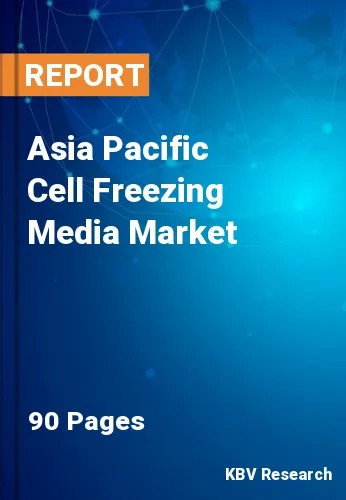The Asia Pacific Cell Freezing Media Market would witness market growth of 10.5% CAGR during the forecast period (2023-2030).
Improvements in the creation of cell freezing media and cryopreservation methods, as well as leveraged uses of cell freezing media in the study of stem cells and tissue engineering, have significantly increased market growth. The market is also anticipated to benefit from favorable government regulations for cell-based research and regenerative medicine. The University of Sydney has received funding for three projects totaling $6.3 million that will target adult blindness and chronic heart disease and aid in expanding the accessibility of stem cell interventions. The $20 billion Medical Research Future Fund, which the Australian government prioritizes for medical research, will invest $150 million in the Stem Cell Mission over nine years.
For blood diseases like leukemia, Hodgkin's disease, and non-Hodgkin lymphoma, stem cell therapy has been successfully used. There is now hope for therapies and a cure where there was none before because of the potential of stem cells to heal many other forms of incurable diseases. As more research takes place in similar fields, the demand will increase. Additionally, growing expenditures in the biotechnology and pharmaceutical sectors for medication development and other uses are the main driver propelling the market. The availability of cutting-edge products will probably boost the product's demand and sales.
Japan is the third-largest pharmaceutical industry in the world and a crucial export market, according to International Trade Administration data published in 2022. Using an accelerated regulatory review procedure known as the Sakigake designation, Japan opened the floodgates to its gene therapy industry in early 2019. Under the Sakigake designation, the Japan Pharmaceutical Medical Device Agency (PMDA) approved two gene therapy medicines concurrently and anticipated approving at least one therapy each year. Therefore, the region has a developing pharmaceutical sector and numerous research prospects. Owing to all these factors, the regional market will expand throughout the forecast period.
The China market dominated the Asia Pacific Cell Freezing Media Market by Country in 2022, and would continue to be a dominant market till 2030; thereby, achieving a market value of $21,370.9 Thousands by 2030. The Japan market is poised to grow at a CAGR of 9.8% during (2023 - 2030). Additionally, The India market would witness a CAGR of 11.2% during (2023 - 2030).
Based on Product, the market is segmented into DMSO, Glycerol, and Others. Based on Application, the market is segmented into Stem Cell lines, Cancer Cell Lines, and Others. Based on End-Use, the market is segmented into Pharmaceutical & Biotechnological Companies, Research & Academic Institutes, and Others. Based on countries, the market is segmented into China, Japan, India, South Korea, Singapore, Malaysia, and Rest of Asia Pacific.
Free Valuable Insights: The Worldwide Cell Freezing Media Market is Projected to reach USD 283.7 Million by 2030, at a CAGR of 9.7%
The market research report covers the analysis of key stake holders of the market. Key companies profiled in the report include Thermo Fisher Scientific, Inc., Merck KGaA, Sartorius AG, Bio-Techne Corporation, HiMedia Laboratories Pvt. Ltd., BPS Bioscience, Inc., BioLife Solutions, Inc., PromoCell GmbH, Capricorn Scientific GmbH, and Cell Applications, Inc.
By Product
By Application
By End-Use
By Country
Our team of dedicated experts can provide you with attractive expansion opportunities for your business.

